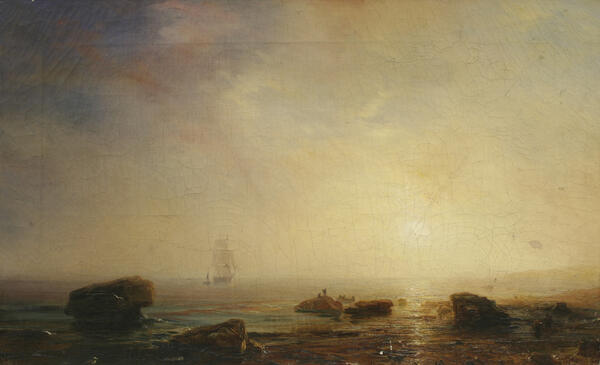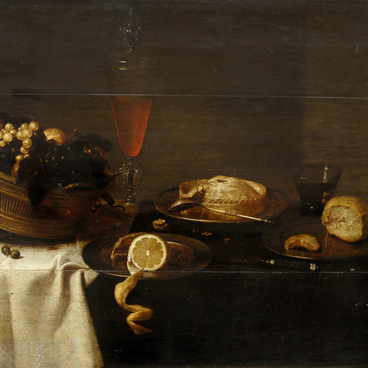The painting “Marine” entered the collection of the Primorye Art Gallery as attributed to another French landscape painter Gaspard Dughet. He was nicknamed “Gaspard Poussin” because he was influenced by Nicolas Poussin, one of the founders of Classicism in painting. However, when the researcher Natalya Levdanskaya studied the canvas, she noticed a signature “T. Gudin. 1851” against the background of the coast on the right. The inscription is hard to notice at first sight. This explains why it was not mentioned in the inventory card.
A comparison of Gaspard Dughet’s classical landscapes with “Marine” from the Primorye Gallery makes it evident that the image of the sea was not typical of Dughet’s art. Most likely, he did not paint seascapes. Moreover, although this assumption might require further proof, 17th-century European artists almost never painted the sea and the sky from life. The attribution of this painting to Dughet is also contradicted by the stamp on the back of the canvas which reads “Paris”. This means that the canvas was produced in Paris. On the other hand, Dughet spent his whole life in Rome and most likely would have used an Italian canvas, as opposed to the 19th-century French artist Jean Antoine Théodore Gudin who became famous when he was still alive and was particularly known for his seascapes. Presumably, he also painted “Marine” from the museum collection.
Jean Antoine Théodore Gudin was born in Paris in 1802. He served in the navy for three years and after that, started taking painting classes. In 1822, he made his debut at the Paris Salon and received a medal. In 1841, he was invited by Nicholas I of Russia and went to work in Saint Petersburg. Usually, Gudin depicted sea battles and shipwrecks. He had a great sense of tonal harmony and the color palette and was good at choosing sea views. In 1844, Gudin was commissioned to produce a series on French naval history for the Palace of Versailles. He was awarded the title of “Peintre de la Marine” — the official artist of the French Navy.
A comparison of Gaspard Dughet’s classical landscapes with “Marine” from the Primorye Gallery makes it evident that the image of the sea was not typical of Dughet’s art. Most likely, he did not paint seascapes. Moreover, although this assumption might require further proof, 17th-century European artists almost never painted the sea and the sky from life. The attribution of this painting to Dughet is also contradicted by the stamp on the back of the canvas which reads “Paris”. This means that the canvas was produced in Paris. On the other hand, Dughet spent his whole life in Rome and most likely would have used an Italian canvas, as opposed to the 19th-century French artist Jean Antoine Théodore Gudin who became famous when he was still alive and was particularly known for his seascapes. Presumably, he also painted “Marine” from the museum collection.
Jean Antoine Théodore Gudin was born in Paris in 1802. He served in the navy for three years and after that, started taking painting classes. In 1822, he made his debut at the Paris Salon and received a medal. In 1841, he was invited by Nicholas I of Russia and went to work in Saint Petersburg. Usually, Gudin depicted sea battles and shipwrecks. He had a great sense of tonal harmony and the color palette and was good at choosing sea views. In 1844, Gudin was commissioned to produce a series on French naval history for the Palace of Versailles. He was awarded the title of “Peintre de la Marine” — the official artist of the French Navy.




